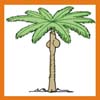From TKWB - Traditional Knowledge World Bank
Jump to navigation
Jump to search
| GENERAL DEFINITION OF THE TECHNIQUE |

|
| Technique: |
DOMESTICATION AND DISSEMINATION OF PALM TREE |
|
Definition characters description and diffusion
The domestication of the date palm, foenix dactilifera, is a precondition for the establishment of desert oases. They often originate from a single palm tree, planted in a hollow in the ground and surrunded by dry branches, which protect it from the sand. As the time goes by, large tilled fields develop along terraced canyons or on green archipelagos among the dunes, thanks to compelx and diversified techniques of water production, land organization, and microclimate formation.
General characters description and diffusion
On a different scale, the oasis effect works following the same principle: the installation of a self-propulsory and self-generating virtuous cycle. The date palm is not a spontaneous tree but the result of domestication and cultivation. In the desert, each palm grove has been planted and lovingly tended and watered. The places and the dates of the early domestication of palm trees are not easy to establish. The origins of this plant date back to the myths of the fortunate island, of the earth of the blessed souls and of the first paradise gardens. The Sumerians and the Egyptians called Dilmun the Edenic island where the first domestic palm tree was produced. This mythical place has been identified with Bahrein, in the Arabian-Perisan Gulf (Cleuziou, 1988). The island has been cultivated since the 6th millennium and at the end of the 4th millennium it was organized around an accomplished economy typical of an oasis and involving the palm-grove agriculture as well as fishing and pastoralism (Cleuziou and Laureano, 1999). This would confirm the ancient myth of Eden being on an island and other plausible circumstances support the theory. On the shoreline, a large family group can at the same time cultivate a palm-grove, breed cattle, fish and sail, exploiting the different possibilities of success of these practices when different possibilities combine in one or more island, it gives rise to a niche of intensification and the prodigious creation of a seashore oasis. The Saharan civilization of Tassili of Ajjer could be pointed out as a further area of early domestication dating back to the same time as Bahrein. However the finding of prehistoric paintings representing date palms of an uncertain date is insufficient proof of this hypothesis. The process of dissemination of the cultivation of palm trees, which began in the 4th millennium in the well-watered areas of Mesopotamia, the Persian Gulf, and the Nile can be more surely followed up. From these areas, in the 3rd millennium palm groves spread up to the Indo valley to the east and in the 2nd millennium up to Crete. The process of implantation of oases slowly proceeded from east to west in the innermost Sahara which has been cultivated since the 1st millennium thanks to the employment of the technique of the drainage tunnels. In the first centuries of the Modern Age the palm groves spread up to the Canary Island, the Spanish and Sicilian coasts.
Advantages and sustainability
The domestication of the plam tree has allowed for the establishment of sustianable cities in the oases of the desert, through the creation of microclimates made possible by the groves of palm trees.
Images
Deepening
|
TRADITIONAL TECHNIQUE DATA
| Technique |
| DOMESTICATION AND DISSEMINATION OF PALM TREE |
| Icon |
 |
| Cathegory |
| B - Agriculture |
| Identification code |
| B7a |
| Author: |
|
| Other authors: |
|
| Reference: |
|
|
|